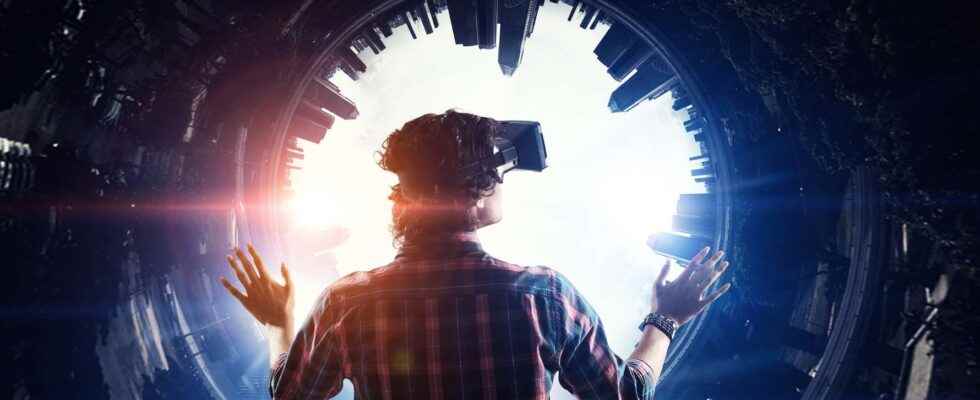Definition of Virtual Reality : Virtual reality (in English, virtual reality or VR) is a technology that allows a person to be immersed in a digitally created artificial world. It should not be confused with augmented reality (see our file on the augmented reality and its applications).
It can be a reproduction of the real world or a universe totally imaginary. The experience is both visual, auditory and, in some cases, haptic with the production of an effects return. When the person is equipped with the appropriate interfaces, such as gloves or clothing, they can then experience certain sensations related to touch or certain actions (blow, impact, etc.).
virtual reality headsets
This immersion is done by means of a virtual reality helmet which places a stereoscopic 3D display system on the nose, in front of eyes. Some models are equipped with sensors that detect the movements of the head to allow the user to look around. The images are then recalculated in real time to synchronize with the direction of gaze.
virtual reality rooms
There are also virtual reality rooms in which the images are projected onto the walls, the floor and the ceiling with a motion capture system that is used to adjust the perspective according to movements.
Virtual reality and its applications: video games, simulators, etc.
Virtual reality for the general public has experienced a boom since 2015 with the arrival of headsets that are both more efficient and affordable. google played the democratization card by proposing a cardboard model called Carboard which is used with a smart phone as a display system.
Several manufacturers including Samsung (Gear VR), HTC (HTC Vive), Sony (PlayStation VR) and Oculus (Oculus Rift) have released helmets equipped with motion sensors mainly intended for video games and apps recreational. More expensive, they are connected to a computer or a game console.
Virtual reality also has many other applications: training with simulators, treatment of phobias, simulation of surgical acts, architecture, archeology with the reconstruction of sites, virtual tours of museums, etc.
What is virtual reality?
The term virtual reality encompasses a series of computer technologies that aim to immerse one or more people in a virtual environment created by software. An environment that more or less faithfully reproduces a real setting.
The user accesses the virtual set through a virtual reality headset. For the immersion to be total, virtual reality does not only use the view of the environment recreated by the software.
Other senses likesmell (diffusion odors), hearing (episode sounds) and touch can be stimulated.
Virtual reality is sometimes referred to as VR (Virtual Reality), computer-simulated reality, or immersive multimedia. It is sometimes mistakenly confused with augmented reality, which is based on a real environment with the addition of virtual elements (hence the term augmented reality, which corresponds in some way to an improvement in reality).
what is virtual reality used for?
For the general public, virtual reality is very often associated with video games. You adjust your helmet, you put yourself in the shoes of a soldier who must overcome obstacles and kill as many enemies as possible. Some music videos and 3D movies also rely on VR. But the endings of computer-simulated reality aren’t just fun.
In the military field, this advanced technology is used, for example, to train airplane pilots and paratroopers.
In the field of health, she helps surgeons before an intervention and helps to treat certain patients with uncontrollable fear such asagoraphobia (fear of crowds), thearachnophobia (fear of spiders) or theacrophobia (fear of heights). Commercial applications are also increasing.
Some transport companies and insurance companies use virtual reality for advertising purposes to catapult the customer inside their vehicles or to make them aware of real dangers such as accidents of the road. VR also has its place in education, especially in the context of virtual videoconferencing, and in architecture to visit buildings before they are construction.
How does virtual reality work?
The virtual reality headset has the heavy task of sending you into a virtual environment by making you believe that the scenes that occur there are indeed real. How does this accessory exert its power of persuasion? Largely thanks to its stereoscopic screen.
Your two eyes see the same images, but not quite at the same angle in order to obtain an effect of depth. The parallax also contributes to the depth. This technique consists of moving certain objects more slowly to accentuate the distance that separates them from the user.
the realism movements is obtained with several sensors: the gyroscope for angles, the accelerometer for 3D movements, and the magnetometer to detect the position of the helmet. These sensors are grouped together under the name “head-traking”. On the audio side, immersion is ensured by spatialized sound which reproduces noise from different angles depending on the position of the user.
You will also be interested
Interested in what you just read?
